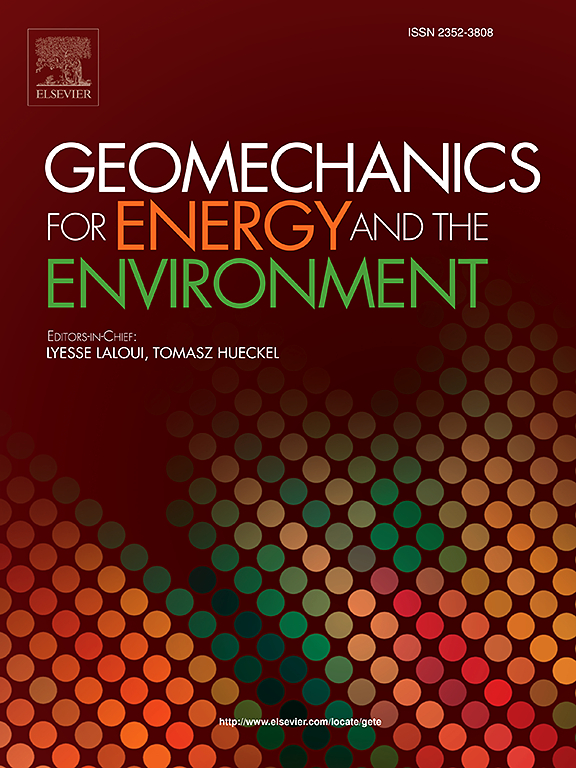岩石塑性域三维分形弹塑性本构模型
IF 3.7
2区 工程技术
Q3 ENERGY & FUELS
引用次数: 0
摘要
在高三维地应力作用下,岩石过渡到韧性域,经历连续的塑性硬化和体积收缩。准确描述岩石在韧性域内的三维各向异性变形对深部地下工程具有重要意义。因此,本研究提出了包含屈服函数和分数流动规则的塑性域三维分数弹塑性本构。塑性屈服函数基于修正的Mohr-Coulomb准则和广义的Matsuoka-Nakai偏差函数。屈服面偏应力与静水压力呈负相关,与Lode角呈正相关。子午面和偏面屈服面随塑性内变量的变化而变化,准确地捕捉了硬化过程中的应力状态。用两个不同的分数阶来控制子午面和偏面内的塑性流动方向,分别用膨胀角和塑性挠度角表示。这些分数阶是根据塑性剪切应变和体积应变之间的关系确定的,它们随着塑性内部变量的变化而变化,有效地捕捉了整个硬化过程中的塑性流动方向。利用静水压缩和真三轴试验的绿砂岩数据验证了所提出的模型。讨论了分数阶对膨胀角和塑性挠曲角的影响。在分数阶的影响下,膨胀角和塑性挠度的范围从0°到−90°。此外,还对非正交和正交流动规律进行了比较。这些结果表明,分数流动规则显著提高了本构模型的适用性和准确性。本文章由计算机程序翻译,如有差异,请以英文原文为准。
A three-dimensional fractional elastoplastic constitutive model for rocks within ductile domain
Under the influence of high three-dimensional geostress, rocks transition into the ductile domain, undergoing continuous plastic hardening and volumetric contraction. Accurately describing the three-dimensional anisotropic deformation of rocks within ductile domain is of great significance for deep underground engineering. Therefore, a three-dimensional fractional elastoplastic constitutive within ductile domain is proposed in this study, including yield function and fractional flow rule. The ductile yield function is based on the modified Mohr-Coulomb criterion and generalized Matsuoka-Nakai deviatoric function. The deviatoric stress of yield surface is negatively correlated to hydrostatic pressure, but positively correlated to Lode angle. The yield surfaces in both meridian and deviatoric planes evolve with the plastic internal variable, accurately capturing the stress state during hardening. Two different fractional orders are used to control the plastic flow direction within meridian and deviatoric planes, represented by dilation angle and plastic deflection angle, respectively. These fractional orders are determined based on the relationship between plastic shear strain and volumetric strain, and they vary with the plastic internal variable, effectively capturing the plastic flow direction throughout hardening. The proposed model is validated using green sandstone data from hydrostatic compression and true-triaxial tests. The effect of fractional orders on the dilation angle and plastic deflection angle is discussed. Under the influence of fractional orders, both dilation angle and plastic deflection angle range from to . Besides, a comparison between the non-orthogonality and orthogonality flow rules is made. These results indicate that the fractional flow rule significantly improves the applicability and accuracy of constitutive model.
求助全文
通过发布文献求助,成功后即可免费获取论文全文。
去求助
来源期刊

Geomechanics for Energy and the Environment
Earth and Planetary Sciences-Geotechnical Engineering and Engineering Geology
CiteScore
5.90
自引率
11.80%
发文量
87
期刊介绍:
The aim of the Journal is to publish research results of the highest quality and of lasting importance on the subject of geomechanics, with the focus on applications to geological energy production and storage, and the interaction of soils and rocks with the natural and engineered environment. Special attention is given to concepts and developments of new energy geotechnologies that comprise intrinsic mechanisms protecting the environment against a potential engineering induced damage, hence warranting sustainable usage of energy resources.
The scope of the journal is broad, including fundamental concepts in geomechanics and mechanics of porous media, the experiments and analysis of novel phenomena and applications. Of special interest are issues resulting from coupling of particular physics, chemistry and biology of external forcings, as well as of pore fluid/gas and minerals to the solid mechanics of the medium skeleton and pore fluid mechanics. The multi-scale and inter-scale interactions between the phenomena and the behavior representations are also of particular interest. Contributions to general theoretical approach to these issues, but of potential reference to geomechanics in its context of energy and the environment are also most welcome.
 求助内容:
求助内容: 应助结果提醒方式:
应助结果提醒方式:


